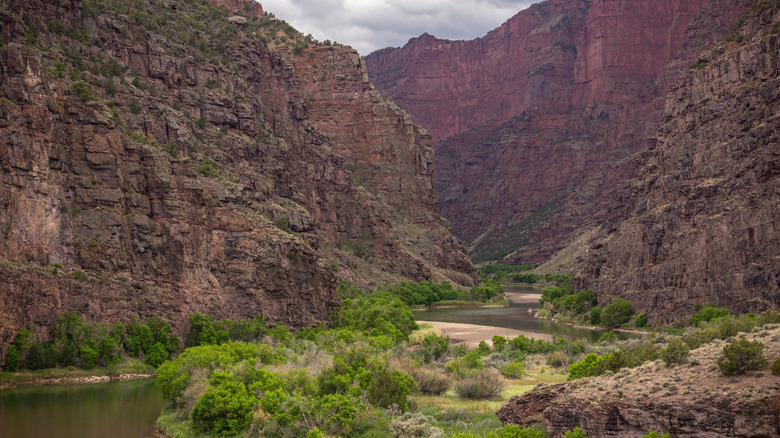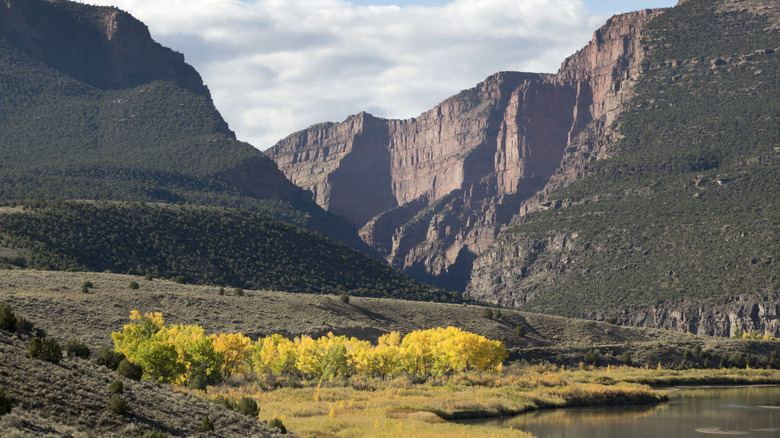Colorado's Sculpted Canyon Is A Red-Rock Reverie Of Folding Cliffs And Glassy Pools Surrounding The Green River
The almighty Grand Canyon earned its status as a globally recognized wonder of the world not merely for its epic size and dazzling depths, but also because of its eye-catching red rock coloration. Yet while the famed Arizona gorge is by far the most famous red-rock canyon in America, that type of red sandstone is widespread across much of the desert basins and mountain ranges in the American West. As a result, you can find many other amazing red-rock canyons, many with views rivaling even the Grand Canyon itself. For example, California's appropriately named Red Rock Canyon State Park is a vivid red rock paradise of desert sandstone cliffs. Yet for a truly rugged red rock canyon experience in a less-visited area, look no further than the western edge of Colorado and the quiet majesty of the Gates of Lodore.
Right away, "Gates of Lodore" sounds like something straight out of a fantasy novel. The name actually comes from a poem called "The Cataract of Lodore" by 19th-century British poet Robert Southey, whimsically describing an English cascade known as Lodore Falls. Other than select English majors, however, most visitors will take the name's high fantasy connotation as an apt description.
The canyon's location in Western Colorado provides it with fantastic, poetic, and perhaps otherworldly scenery more indicative of the deserts of Utah than the Colorado Rockies (the canyon is only four and a half hours from Salt Lake City by car, for those who fly into Salt Lake City International Airport ). And while its sculpted red cliffs and enchanting waterways make the canyon stand out, the Gates of Lodore also has the distinction of being a hidden gem in one of the best (and most underappreciated) national park sites in the American West.
The Gates of Lodore is an unsung natural wonder in an unsung national park
Many prominent western canyons like the Grand Canyon, the Black Canyon of the Gunnison, and Canyonlands are the central features of their own national parks. The Gates of Lodore, however, is tucked away in a remote northern section of Dinosaur National Monument. Straddling the border between Colorado and Utah, Dinosaur National Monument is already a spectacular showcase of the geological (and paleontological) wonders of the Four Corners region.
As you might have guessed from its name, Dinosaur National Monument is best known for its rich fossil quarries that produced many prominent dinosaur fossils standing in museums across the world today. Yet even die-hard dino fans can't deny that the park's aboveground features are amazing as well. The park's landscape is defined by the alluring Uinta Mountains and their junction with the rugged Yampa and Green Rivers. The beautiful yet underrated Uinta Mountains are the highest in Utah, and with the park's dual river system, they create a distinctively American landscape that looks straight out of a classic Western.
Of the park's two rivers, the Green River is the one responsible for the formidable Gates of Lodore canyon. Further north, the river rolls through a relatively flat valley, but as it enters the Uinta Mountains, it makes a dramatic southward turn and begins cutting through billion-year-old rock. The result of this epic hydropower is a canyon carved by water and time into truly epic red cliffs and towering rocky peaks ascending from the river banks on all sides. To complement the canyon's gargantuan red cliffs, the Green River uses this canyon excursion to live up to its name and display an emerald-like hue adorning the waterway's more tempestuous sections.
For all its remote beauty, Gates of Lodore is a top rafting destination
Based on this description, you may assume that the Gates of Lodore is a remote and pristine canyon landscape. And it is! And yet, for all its rugged qualities (or, perhaps, because of them), the Gates of Lodore is also a world-class destination for thrilling river rafting trips. A trip down Green River will provide the proverbial "best views in the house" of the canyon's awe-inspiring red cliffs (not to mention a good billion years of the Earth's geological history displayed in the exposed rock layers). If you're more interested in thrills than education, however, the Gates of Lodore also offers class II, III, and IV rapids. When experiencing the canyon from the river, you can be gawking up at 2,500-foot-high cliffs one moment, and braving adrenaline-inducing rapids the next!
During the 40+-mile Gates of Lodore rafting journey, you'll pass by remarkable geologic landmarks, such as the 1,050-foot-high and one-mile-long Steamboat Rock and the remarkably shaped, multicolored Mitten Park Fault. Even if you're not keen on getting wet from the Green River's ample rapids, you can still experience the Gates of Lodore's remarkable scenery on foot.
As formidable as the canyon's landscape is, the main Gates of Lodore Trail is a surprisingly easy hike just under a mile in length, which somehow manages to avoid sacrificing extraordinary views. The Gates of Lodore Campground is conveniently located right along the banks of the Green River next to the main boat ramp, though you can also find more modern lodging in nearby towns like Vernal, Utah, which has a regional airport that offers flights to and from Phoenix and Denver. You can keep up the fantasy theme by visiting the alien-like sandstone formations in Vernal's Fantasy Canyon while you're there.


